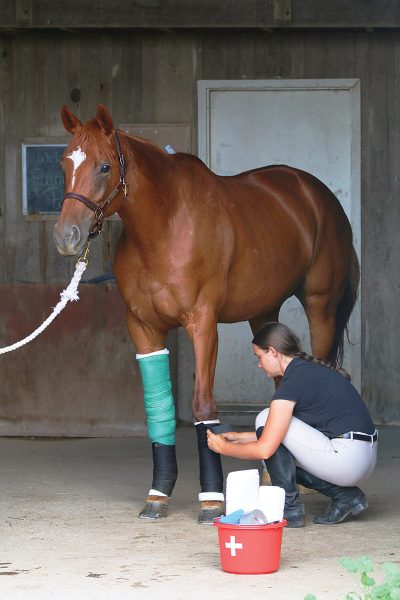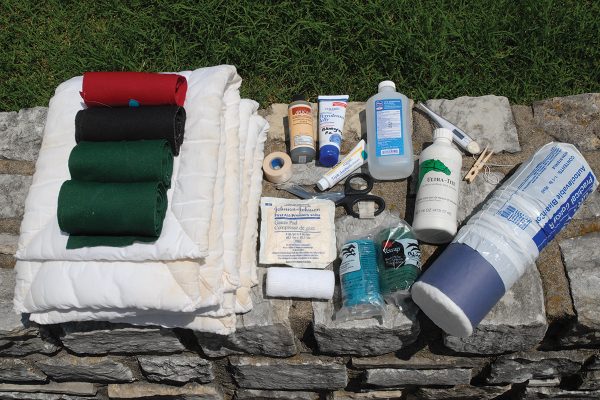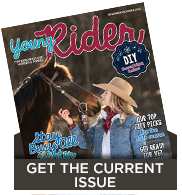Our accident-prone horses often come up with all kinds of creative ways to scrape, cut, bump, bruise, and otherwise injure themselves. It’s a good idea to be prepared for this. Every horse owner should have a basic first-aid kit on hand for equine accidents and emergencies (see “First-Aid Kit Checklist,” below) for proper wound and injury care. In addition to having a first-aid kit, you also need to know how to use the items in it correctly.
Talk to your vet for advice on products and treatment they recommend for minor wounds, and what to do in case of a serious injury and emergency. Make sure you know how to reach your vet in an emergency, and keep their number by the barn phone and stored in your cell phone, if you have one.

Safety Precautions
When your horse greets you at the gate with a bleeding wound, stay calm and don’t panic. It’s sometimes easier said than done, but being calm, quiet, and in control will help your horse stay calm, too.
While you may be worried about your horse, you also need to keep human safety in mind. A horse that is injured or in pain may be upset and difficult to handle, which may mean you need help from an adult. In this situation, it’s also a good idea to show the wound to an adult so they can help you treat it properly.
Determine How Serious Your Horse’s Wound Is
Some wounds need to be treated by a vet. These include wounds on a leg, a joint, or an eye; those with major bleeding; deep wounds; puncture wounds; and gaping wounds that may need stitches. If you suspect that a wound needs stitches or veterinary attention, call the vet as soon as possible.
After a number of hours, it may be too late to stitch a wound. And a horse can sometimes make it worse by moving around too much before he is stitched up. It should be OK to clean the wound with water or cover it with a nonstick sterile dressing and a bandage to keep it clean until the vet arrives, but avoid putting any antiseptic, ointment, or other treatment on the wound so that it doesn’t obstruct your vet’s view of it.
When serious bleeding occurs, do your best to control the bleeding while you wait for the vet. Once you have the horse quiet and under control, apply pressure directly on the wound using either a clean cloth, feminine pad, or several clean gauze pads. Keep the pressure on until the bleeding stops or the vet arrives. If the wound is on a leg, you can apply a stable bandage to hold the padding in place.
First-Aid Care of Minor Wounds
It’s best to follow your veterinarian’s advice on how to treat minor wounds, but here are some helpful basic steps from the USPC Manual of Horsemanship, Intermediate Level C1-C2:
1. Hose the wound with a gentle stream of cool water for 10 minutes to remove dirt and large debris stuck to the surface.
2. Clean the wound gently using saline solution, sterile or bottled water, and an antibacterial soap, chlorhexidine, or other mild soap. Start from the area above the wound and clean from the top down. Use gauze pads and change out dirty ones for fresh ones as needed.
3. Let the wound dry or blot gently with a sterile gauze square.
4. If the wound is small, apply an antibiotic ointment, such as human triple antibiotic ointment (like Neosporin) or whatever product your veterinarian recommends. Avoid strong antiseptics such as peroxide, alcohol, iodine, et cetera, as these can damage the tissues and interfere with healing.
5. If the wound is in a place that may get dirty and can be bandaged, such as a leg, you should protect it with a dressing and a bandage. Apply a large, sterile non-stick gauze dressing over the wound and apply a stable bandage over it.
6. If the area can’t be bandaged, follow your veterinarian’s advice for any treatment to apply, such as antibiotic ointment or powder. Check the wound frequently to be sure it isn’t contaminated with dirt or bedding. Clean gently with running water as needed and avoid scrubbing, which can damage the healing tissue.
Your veterinarian is the best source of advice for first-aid and healthcare recommendations for your horse or pony. It’s always good to talk to them about these things before you have an emergency. Following your vet’s advice makes treating your horse easier for them and may keep you from making a mistake. Veterinarians often go to Pony Club meetings to talk about equine first-aid and other horse health topics.
Find more information about wound care and first-aid in the USPC Manual of Horsemanship, Intermediate Horsemanship C1-C2 Level (pg. 216-221).
Horse First-Aid Kit Checklist

As a horse owner, you should have a basic first-aid kit on hand in case of accidents or emergencies. Store your kit where it will stay clean and organized, such as a plastic bin with a lid, and put items that might leak in a zip-top bag. Check your kit at least twice a year to restock items that have run low or expired.
Here is a sample list, adapted from the USPC Manual of Horsemanship, Intermediate Horsemanship C1-C2 Level:
◆ Digital thermometer
◆ Petroleum jelly (Vaseline)
◆ Isopropyl alcohol (rubbing alcohol)
◆ Betadine, chlorhexidine, or antiseptic soap
◆ Sterile saline solution or bottled water for cleaning wounds
◆ Liniment
◆ Human triple antibiotic ointment (like Neosporin) or wound dressing
recommended by your veterinarian
◆ Sterile nonstick wound dressings
◆ Gauze squares, 4×4 inches
◆ Absorbent pads (nondeodorant-type feminine pads work well)
◆ 1 roll of gauze (at least 2 inches wide)
◆ 2 rolls of stretch adhesive/cohesive crepe bandages (Vetrap or similar type)
◆ Absorbent practical cotton (12-inch, 1-pound roll)
◆ Bandage scissors (with blunt ends)
◆ 1 roll of adhesive tape (at least 1 inch wide; also known as cloth sports tape or bandage tape)
◆ 4 leg bandages (such as track bandages, flannel bandages, or knit bandages with Velcro closures)
◆ Appropriate padding for 4 stable wraps (such as quilts, pillow wraps or no-bow wraps)
◆ Notebook and pencil
Brought to you in partnership with The United States Pony Clubs, Inc. Join Pony Club for more lessons like this! Find a Pony Club or Pony Club Riding Center near you and learn more at www.ponyclub.org.
This article about horse first-aid and wound care appeared in the November/December 2023 issue of Young Rider magazine. Click here to subscribe!


